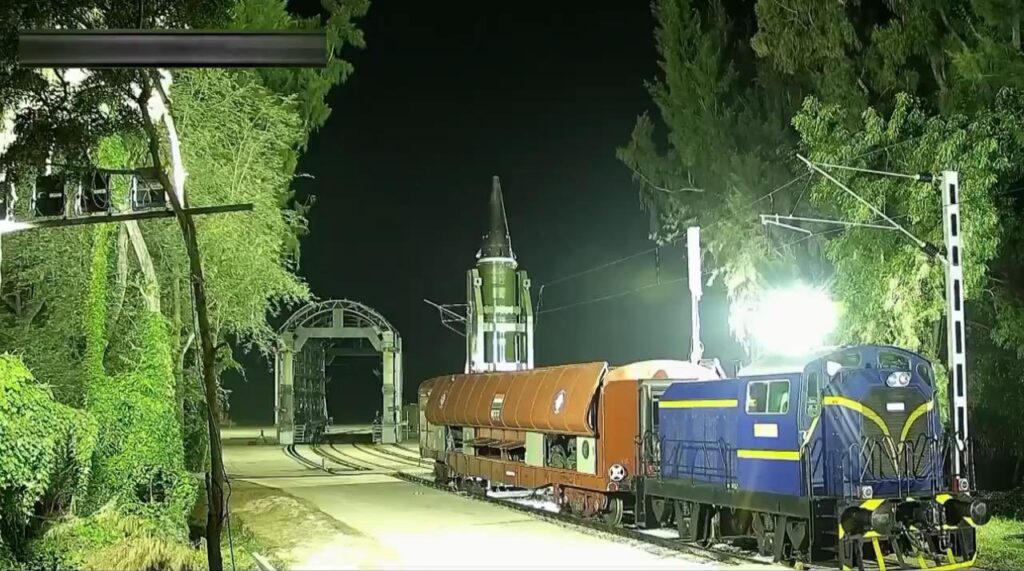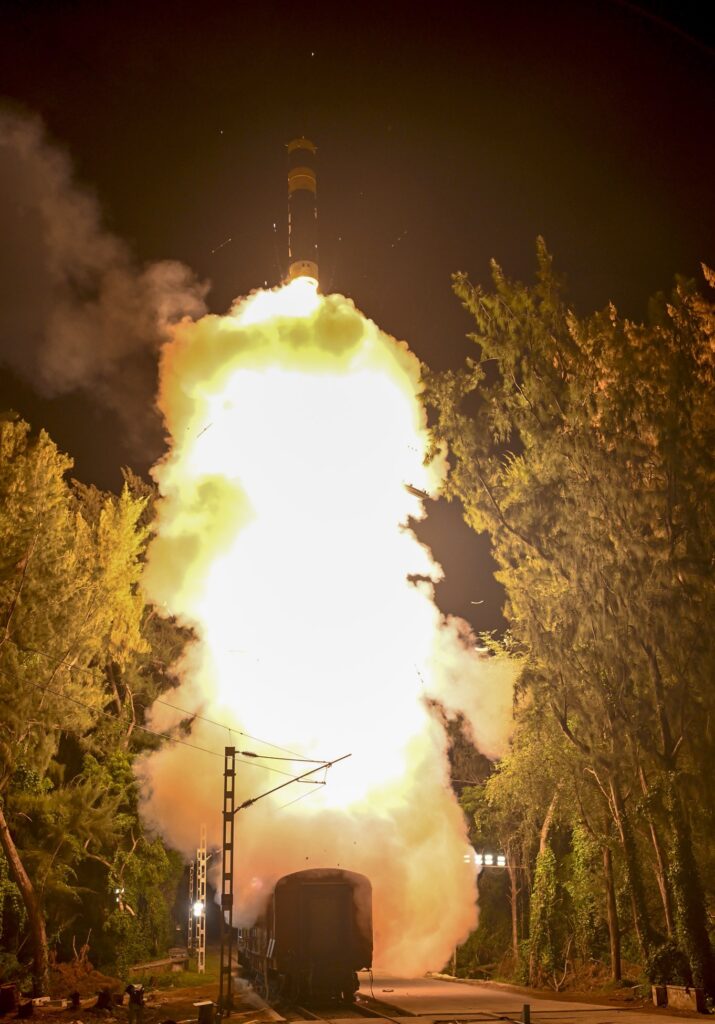A missile roaring out of a train carriage — it sounds like a scene from a thriller, but on Wednesday, India turned that vision into reality.
In a groundbreaking achievement that has placed India among the select few nations with advanced rail-based missile deployment capabilities, the Defence Research and Development Organisation (DRDO) successfully conducted the first-ever train-launched test of the nuclear-capable Agni missile on Wednesday. The test marks a historic milestone in India’s strategic defence preparedness, giving the country unprecedented mobility and stealth advantages in missile deployment.
The test, carried out from a specially modified train somewhere in the central plains of India, demonstrated the country’s capability to launch long-range missiles from rail-based platforms — a feat that dramatically enhances survivability in case of conflict. The missile, part of the Agni series of nuclear-capable ballistic missiles, was fired from a concealed launcher integrated into a train wagon designed to appear like an ordinary freight carrier.
A Stealthy Leap Forward
Until now, India’s Agni series — ranging from Agni-I (700 km) to Agni-V (over 5,000 km) — had been launched from land-based silos and road-mobile launchers. While effective, such methods could still be vulnerable to satellite surveillance and preemptive strikes during conflict. With the rail-launch capability, India has gained a new layer of stealth, mobility, and unpredictability.
“Today’s test validates India’s entry into a new era of missile deployment. The rail-based system makes our deterrent more survivable, giving us a second-strike capability even in the harshest scenarios,” a senior defence official told reporters after the test.
Unlike static silos, which can be easily tracked, or road launchers, which have geographical limitations, train-based launchers can move across thousands of kilometers of railway tracks. This means a missile could potentially be launched from anywhere, making it nearly impossible for adversaries to pinpoint its location.
How the Test Was Conducted
The trial involved months of planning, integration, and secrecy. Engineers from DRDO’s Advanced Systems Laboratory (ASL) in Hyderabad and the Research Centre Imarat (RCI) worked alongside Indian Railways to develop a disguised train platform capable of handling the enormous stress of a ballistic missile launch.
The launch wagon was designed to withstand the backblast and vibrations of a missile taking off vertically, while appearing to the outside world like an ordinary freight carriage. The missile was kept concealed under a retractable roof, which opened only moments before ignition.
At precisely 9:30 a.m., the Agni missile roared into the sky from its railway-mounted launcher. DRDO scientists confirmed that the missile met all mission objectives, covering its designated range and successfully hitting a pre-determined impact point in the Indian Ocean. Real-time tracking was conducted by radars, telemetry stations, and naval ships positioned along the missile’s trajectory.
“The missile’s guidance, accuracy, and propulsion performed flawlessly. The integration of the system with the rail platform worked beyond expectations,” said Dr. Samir V. Kamat, Chairman of DRDO, in a post-test briefing.
Why This Matters
The successful test is not just a technological triumph but a strategic breakthrough. Experts believe that rail-based missile systems are crucial for strengthening India’s nuclear deterrence under its doctrine of Credible Minimum Deterrence and No First Use.
“India’s missile programme has matured significantly. With a rail-based Agni system, India’s deterrence becomes far more credible. It ensures survivability even in a nuclear exchange scenario because adversaries can never be sure where these missiles are stationed,” explained Lt. Gen. (Retd.) Deepak Singh, a strategic affairs analyst.
Globally, only a handful of countries, including the United States, Russia, and China, have developed or experimented with rail-based missile systems. India’s successful test places it in this elite club.
A Historical Perspective
India’s missile development journey dates back to the Integrated Guided Missile Development Programme (IGMDP) launched in the 1980s under the leadership of Dr. A.P.J. Abdul Kalam. The Agni missile series, named after the Sanskrit word for fire, became the backbone of India’s strategic arsenal.
Agni-I was first tested in 1989, with a range of around 700 km.
Agni-II, III, and IV extended the reach up to 3,500 km.
Agni-V, India’s first true intercontinental ballistic missile (ICBM), can reach over 5,000 km, covering nearly all of Asia and parts of Europe and Africa.
Now, the train-launched Agni marks the latest evolution, reflecting India’s growing self-reliance and innovation in defence technologies.
Global Reactions
The international response to the test has been a mix of admiration and caution. While most global powers have refrained from officially commenting, analysts note that India’s rail-based system could trigger new strategic calculations in Asia.
China, which has previously experimented with rail-based ICBM systems, is likely to take note of India’s advancement. Pakistan, too, will be watching closely, though its technological capabilities remain far behind in this sphere.
American defence analysts have highlighted the significance of the test, noting that such systems greatly enhance survivability. “Rail-based launchers make a country’s missile arsenal far more resilient to surprise attacks. India’s successful test is a major leap in its strategic posture,” wrote a report from the Washington-based Carnegie Endowment.
The Technical Edge
The train-launch system provides several critical advantages:
1. Mobility: With over 68,000 kilometers of railway tracks across India, missiles can be moved quickly and unpredictably.
2. Camouflage: Launcher wagons resemble ordinary freight trains, making detection extremely difficult.
3. Survivability: In a nuclear strike scenario, dispersed rail-based systems are harder to neutralize than fixed silos.
4. Rapid Deployment: Missiles can be launched from remote regions without building new static bases.
The missile tested is believed to be a variant of Agni-IV, with a range of about 4,000 km, capable of carrying both conventional and nuclear warheads. DRDO officials have hinted that future tests may involve Agni-V, extending India’s strike capability even further.
Domestic Reactions and Political Response
Prime Minister Narendra Modi congratulated DRDO scientists, calling the achievement a “monumental milestone in India’s journey towards strategic self-reliance.”
In a statement on social media, he wrote: “Proud of our scientists and engineers for scripting history. The successful train-launched test of Agni missile strengthens our defence capability and showcases India’s innovation.”
Defence Minister Rajnath Singh also lauded the test, emphasizing its importance for national security. “This success enhances India’s deterrence capability and adds to our robust security architecture. It is a true example of Aatmanirbhar Bharat in defence,” he said.
Opposition leaders, while welcoming the achievement, urged the government to balance military advancements with diplomatic initiatives to ensure regional peace.
A Step Towards Future Defence
The train-launched Agni test is part of a larger modernization drive in India’s strategic forces. Experts believe that the next steps could involve:
Submarine-launched ballistic missiles (SLBMs): Strengthening the sea leg of India’s nuclear triad.
Multiple Independently Targetable Re-entry Vehicles (MIRVs): Allowing one missile to carry several warheads aimed at different targets.
Hypersonic missile systems: For faster, harder-to-intercept weapons.
Together, these advancements could significantly boost India’s strategic deterrence posture in the coming decades.
The Human Element
Behind the steel and fire of the missile lies the dedication of thousands of Indian scientists, engineers, and railway personnel. Many worked in secrecy for years, often away from their families, to develop the rail-launch capability.
Dr. Shilpa Mehra, a project leader at DRDO, described the emotional moment of watching the missile ascend from a train wagon. “It was unreal, like if we were seeing the course of history. We had rehearsed it countless times, but when the missile actually launched, there was a sense of pride and relief beyond words.”
Railway officials, too, expressed pride in collaborating on the project. “For us, it was not just about building a train, but about building a shield for the nation,” said an Indian Railways engineer who worked on the launcher design.
Looking Ahead
Defence experts caution that while the test is a breakthrough, sustained efforts will be needed to operationalize the system. Multiple tests under varied conditions will follow before the rail-based Agni becomes a regular part of India’s Strategic Forces Command.
Still, the symbolic importance of this first test cannot be overstated. It represents not only technological prowess but also strategic maturity — signaling to the world that India is ready to safeguard its sovereignty in an increasingly uncertain global order.
The first-ever train-launched Agni missile test is more than just a defence experiment — it is a statement of India’s technological progress, strategic foresight, and commitment to safeguarding national security. With this achievement, India joins the ranks of global powers that can deploy nuclear-capable missiles from rail-based platforms, enhancing survivability, mobility, and deterrence.
As the missile rose from the tracks and blazed across the sky, it carried not just a payload but also the hopes, pride, and determination of a nation determined to secure its future.
India, quite literally, has put its defence power on track — and the world is watching.
Related News: Read More




